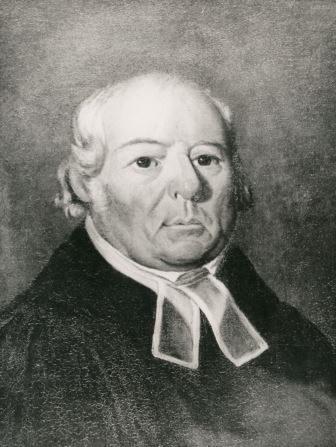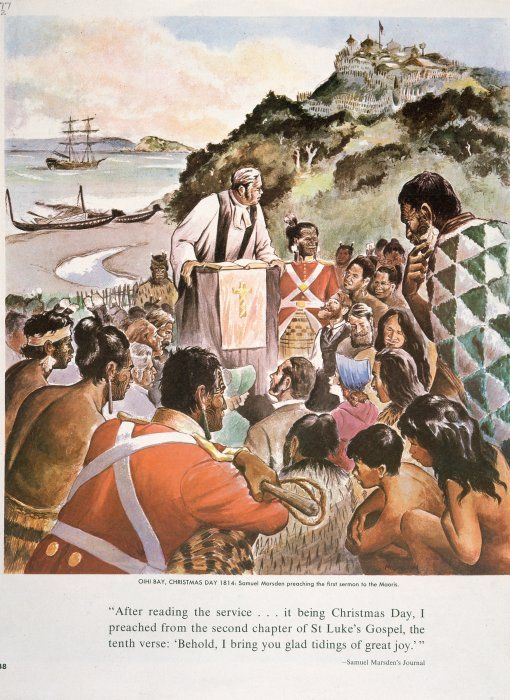Reverend Samuel Marsden (1765–1838)
Marsden was ordained in 1793, and in that same year sailed with his wife Elizabeth for New South Wales. Arriving in March 1794, he took up the position of Assistant Chaplain of New South Wales. He also established a farm at Parramatta, which he grew and extended over the coming decades.

Marsden was a prominent, influential and at times controversial public figure in New South Wales, serving as a magistrate from 1795, superintendent of government affairs and Chaplain of New South Wales from 1800. Although he was skeptical of the value of missionary work directed at Australian Aboriginal communities, he was an enthusiastic supporter of the work of the Missionary Society (later the London Missionary Society) in the Pacific Islands and from 1804. Marsden served as the New South Wales agent for that society’s operations in the Pacific.
He also built close relationships with rangatira who visited Australia, often hosting them at Parramatta. His connections with Te Pahi and Ruatara, in particular, were central in the establishment of the mission in New Zealand in 1814, when Marsden was finally able to bring to fruition a plan he had been contemplating since at least 1807.
On Christmas Day 1814 Marsden preached at Rangihoua from Luke 2:10 – ‘behold, I bring you good tidings of great joy’ – an event that is typically dated as the beginning of Christianity in New Zealand.

Over the following decades, Marsden oversaw the New Zealand mission, visiting frequently and coordinating its activities with the authorities of the Church Missionary Society in London. His relationship with some of the missionaries was often tense as he regulated the mission’s economic activity as well as dispensing discipline.
His commercial acumen, energy, and strong relationships with leading rangatira were central in the development of the mission until his death in 1838.
Key Dates
| 1765 | Samuel Marsden born at Farsley in Yorkshire |
| 1790 | Marsden began attending Magdalene College, Cambridge with the support of the Elland Society. |
| 1793 | Marsden ordained and married Elizabeth Fristan in preparation for travel to New South Wales to take up position as Assistant Chaplain to the convict settlement. |
| 1794 | The Marsdens arrived in New South Wales. |
| 1795 | Marsden appointed as a Magistrate in New South Wales. |
| 1799 | Church Missionary Society formed with involvement from William Wilberforce, who was also prominent in the Elland Society. |
| 1804 | Marsden became agent for the London Missionary Society in New South Wales. |
| 1805 | Marsden meets the Ngā puhi leader, Te Pahi in Port Jackson and they become friends. Marsden develops the idea of establishing a mission at Te Puna under Te Pahi’s protection, Te Pahi is likewise interested in learning more about European trade and technologies. |
| 1806 | Marsden meets Te Pahi’s relative Ruatara in Port Jackson for the first time. |
| 1807 | Samuel and Elizabeth Marsden returned to London to present his case to the Church Missionary Society for a mission to New Zealand. |
| 1809 | Marsden meets Ruatara in an abused state on a ship as he is about to return to Australia. He takes Ruatara into his care and they begin the long voyage back to Port Jackson with lay missionary settlers William Hall and John King. Ruatara is sympathetic to the missionaries' plans to settle in New Zealand as he can see potential benefits for his people. |
| 1809 | The Boyd incident takes place at Whangaroa: most of the ship’s crew are killed and Te Pahi is fatally wounded. Following this incident, few European ships visit the area for several years and the establishment of the mission is delayed. |
| 1810 | The Marsdens arrived back in New South Wales with Ruatara, Hall and King. Ruatara remains at Parramatta with the Marsdens. |
| 1811 | Elizabeth Marsden suffered a stroke while giving birth and was permanently disabled. |
| 1812 | Tuai (Ngati Ruamati) and Maui arrive separately and stay with the Marsdens at Parramatta. |
| Early 1813 | Ruatara is finally able to return to Rangihoua, after sometime spent working on whaling ships between New Zealand and Australia. |
| October 1813 | Thomas Kendall (schoolmaster), the third of the lay settlers recruited for a mission, arrives in New South Wales with his wife, Jane. |
| Late 1813 | Marsden purchases the brig Active to be used to travel between New Zealand and Australia. |
| December 1813 | After discussions with Marsden, Governor Macquarie issues a proclamation to protect the natives of the South Seas, after repeated reports of ill treatment of Māori and Pacific Islanders who were working on ships, and trading with Europeans. |
| March to June 1814 | Thomas Kendall and William Hall and Tuai travel to New Zealand via Tasmania and meet with Ruatara and Hongi Hika and other local chiefs. Ruatara and Hongi Hika and others then return to Parramatta with Kendall and Hall. Hall teaches Hongi and others to write the alphabet and learn the sounds. |
| November to December 1814 | Marsden, Ruatara, Hongi, Korokoro, and Tuai as well as Hall, King and Kendall along with their families and others, including John Liddiard Nicholas, travel to Bay of Islands in December in the Active. |
| 25 December 1814 | Marsden preaches his first sermon in New Zealand to the gathered people of Rangihoua. |
| March 1815 | Marsden returns to Parramatta. At Rangihoua, Ruatara dies as a result of illness. |
| 1815 | Marsden established Seminary at Parramatta for the education of young Māori. |
| 1815 | Kendall has the book A korao no New Zealand; or, the New Zealander's first book; being an attempt to compose some lessons for the instruction of the natives printed and published in Sydney. |
| August 1816 | Kendall begins the school at Rangihoua. |
| 1818 | Titore and Tuai visit England. |
| 1818 | Kendall sends a manuscript of a Māori spelling book to the Church Missionary Society. |
| July to October 1819 | Marsden makes his second visit to the mission. |
| August 1819 | Reverend John Gare Butler along with James and Charlotte Kemp arrive at Kerikeri, and establish the mission there. Butler is appointed as Superintendent of New Zealand under Marsden’s supervision from Parramatta. |
| February to November 1820 | Marsden makes a third visit to the mission. |
| 1820 | Without the permission of Marsden or the Church Missionary Society, Kendall visits England with Hongi Hika and Waikato and they work on A grammar and vocabulary of the language of New Zealand with Samuel Lee in Cambridge. Kendall was ordained during this trip. |
| July 1821 | Kendall returns to the Bay of Islands. |
| August 1822 | Kendall is dismissed from the Church Missionary Society. |
| 1823 | Reverend Henry Williams arrives in the Bay of Islands as the New Zealand head of the Church Missionary Society mission. |
| July to November 1823 | Marsden makes a fourth visit to New Zealand, Butler is suspended as a missionary and returns to England. |
| 1824 | Missionary George Clarke arrives at the Kerikeri mission. Missionary Richard Davis arrives and settles initially at Pahia. |
| Feb 1825 | Kendall and his family leave New Zealand. |
| 1826 | Missionary James Hamlin arrives at the Waimate mission. |
| March 1827 | Marsden makes a short fifth visit to New Zealand. |
| February to May 1830 | Marsden makes a sixth visit to New Zealand. |
| December 1834 | Church Missionary Society lay missionary William Colenso arrives in the Bay of Islands to run the printing press. |
| 1835 | Elizabeth Marsden died. |
| March to July 1837 | Samuel Marsden's seventh and final visit to New Zealand. |
| 1838 | Samuel Marsden died in New South Wales. |

